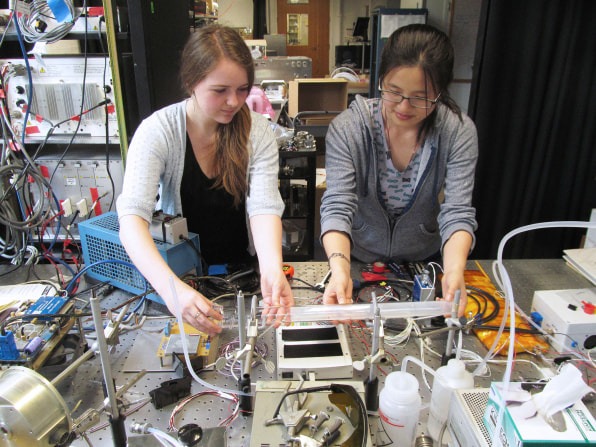In a lab at Harvard, researchers are trying to replicate the conditions of the stratosphere–the part of the atmosphere that stretches roughly six to 31 miles above the surface of the planet–in test tubes. Their goal: to better understand what might happen if humanity eventually decides to embark on a radical, controversial plan to temporarily cool the planet by spraying clouds of particles into the sky.
If it ever happens, the process might involve sending planes into the sky to release particles of a compound like sulfur dioxide that can reflect some sunlight back into space and could temporarily cool the planet. It’s not a fix for climate change, and it’s a form of geoengineering so extreme that it carries risks that may not be fully predictable. But as climate change progresses, it’s possible that the global community may someday decide it has to try it.
“Our team here is doing the research because we believe there’s still a lot of uncertainties around solar geoengineering, and we think there’s a chance for potential benefits around the world,” says Elizabeth Burns, managing director for Harvard’s Solar Geoengineering Research Program. “But we also think there’s the chance for very real risks.”

In one new study in Nature Climate Change, researchers from Harvard, MIT, and Princeton used a state-of-the-art, detailed computer model to look at what might happen if solar geoengineering was used to cut global temperature increases in half. In the scenario, they found that reducing warming would also offset the increasing intensity of hurricanes and would help moderate extreme rain and a lack of water for farming (in the model, rain decreased, but so did evaporation). Less than 0.5% of the world might see increases in impacts from climate change. That’s in contrast to some previous studies that found that this type of geoengineering might benefit some parts of the world while large other areas were harmed. Still, the study is limited, and doesn’t look at all of the potential effects.
The concept of spraying chemicals into the sky to cool the Earth is not new. It’s the same process that happens naturally when volcanoes erupt. In 1991, when Mount Pinatubo erupted and spewed millions of tons of sulfur dioxide into the atmosphere, it cooled the planet by half a degree Celsius for more than a year. But it’s only more recently that researchers have started seriously studying what might happen if humans deliberately do something similar. At this point, it’s still a very small area of study, with relatively little funding, and many unknowns.
Burns emphasizes, repeatedly, that the world’s priority needs to be reducing emissions to zero. “Solar geoengineering cannot be a substitute for reducing emissions, because it does not address the root cause of climate change,” she says. “So if we are to achieve a stable climate, we really do need to reduce emissions to zero, and then also eventually remove the carbon dioxide that’s in the atmosphere and store it underground or elsewhere. Those actions actually address the root cause. Solar geoengineering does not.”
“It would only potentially be used temporarily while we rapidly reduce our emissions to the atmosphere and figure out cheap ways to separate carbon dioxide out,” says Alan Robock, an environmental sciences professor at Princeton. “So nobody talks about doing it instead of mitigation. It would be on top of our best efforts at mitigation.” Robock has documented 27 potential risks of the idea, from the possibility of ozone depletion to potential droughts and a reduction in solar energy generation. The paper lists only six potential benefits, but one is significant: a reduction in surface air temperatures could “reduce or reverse negative impacts of global warming, including floods, droughts, stronger storms, sea ice melting, and sea level rise.”
At Harvard, the researchers are studying the possibility of using calcium carbonate (the same particle found in chalk or toothpaste) rather than sulfur dioxide; while sulfur dioxide can speed up the destruction of the ozone layer, calcium carbonate could potentially help it and avoid some other risks. While their work is focused in the lab and computer modeling now, the team may be the first to do a real-world experiment, which would involve launching a balloon into the stratosphere, releasing a small amount of calcium carbonate, and then measure how the light scatters and changes in atmospheric chemistry. The team was interested in conducting the experiment this year, but won’t move forward without the recommendation of an external, independent advisory committee that it’s creating. “To us, the governance of this is equally as important as the scientific goals for the experiment,” says Burns.
One of the fundamental questions of solar geoengineering is who gets to decide if it happens: For an action that affects the entire planet, who has that right? The actual process may be inexpensive enough (by one estimate, less than $10 billion a year) that there’s a risk that a single country could decide to act unilaterally. That’s part of the reason that the research is so critical; the world needs to understand more about what could happen, and whether it could happen responsibly.
“If the international community is faced with climate change impacts that are severe or more severe than expected, when people are then talking about available tools, we need a better understanding of what solar geoengineering may or may not be able to do,” says Burns. “In our view, it’s not saying that we need it. If anything, I hope we don’t need it. It’s a very scary technology. It’s quite terrifying. But the world with severe climate change impacts can also be very scary. And so I think we’re researching it so that we can better understand the potential benefits as well as the potential risks that would come alongside this technology.”
Bagikan Berita Ini















0 Response to "Scientists are researching cooling the planet by geoengineering - Fast Company"
Post a Comment